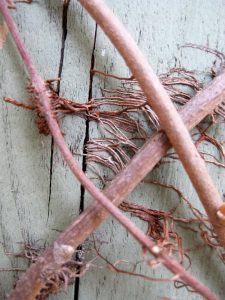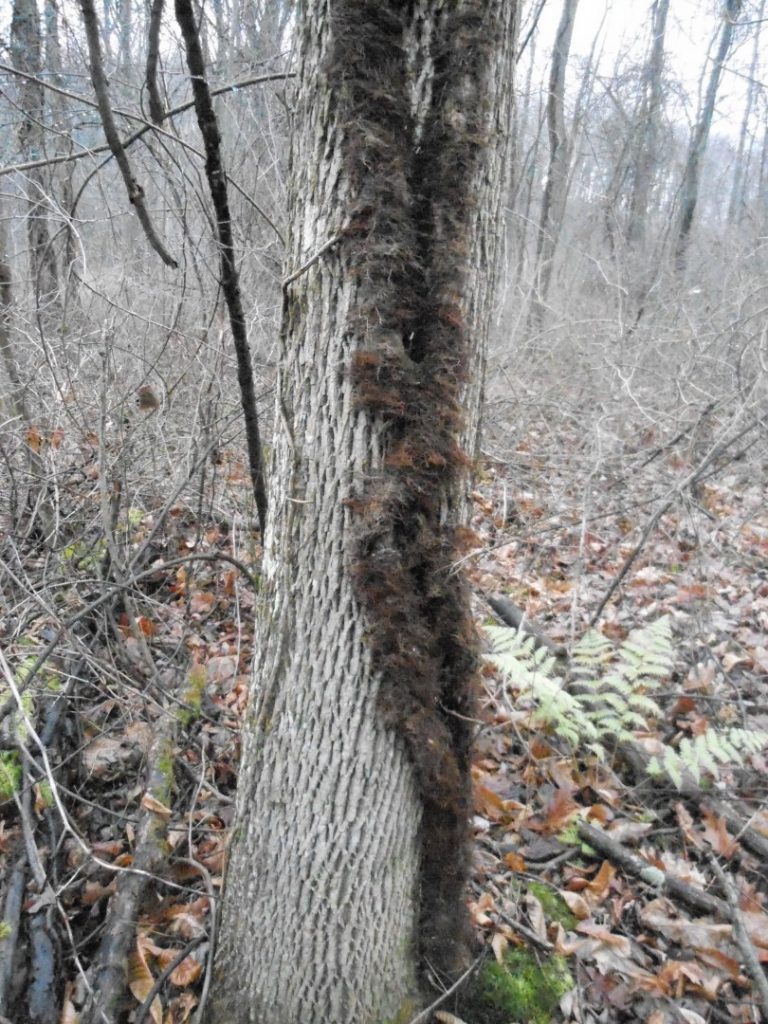Leaflets three, let it be! You’ve probably heard that old bit of sage advice. But how can you tell if it’s poison ivy twined around your backyard tree or chunk of firewood, when the leaflets three are long gone?
Vines climb trees in many different ways–by corkscrewing around the trunk, by using hooks or suction cups or tendrils. But poison ivy’s method of ascent is unmistakable. Poison ivy gets to the top by growing thread-like rootlets all along the length of its stems. At first the rootlets appear as little patches that look like tufts of fuzzy hair.  As the vine ages, more and more rootlets grow, forming a thick pelt of what appears to be auburn fur that covers the entire vine. Very odd–it looks more like a mammal than a plant. Resist the temptation to stroke the fuzzy pelt–it can still cause a rash even in winter.
As the vine ages, more and more rootlets grow, forming a thick pelt of what appears to be auburn fur that covers the entire vine. Very odd–it looks more like a mammal than a plant. Resist the temptation to stroke the fuzzy pelt–it can still cause a rash even in winter.
The wiry little roots dig their way into every tiny crevice in the bark, and hold on tight. If you were daft enough to try to rip a poison ivy vine off a tree, you’d discover that it’s so tightly welded to the tree that often the bark comes off with the vine.
Logs cut up for firewood sometimes have a chunk of PI vine grafted to their side, and are thrown unnoticed into the fire. Tiny droplets of urushiol, the chemical that causes skin irritation, are carried by the smoke, and breathing it in can be extremely dangerous.
Poison ivy doesn’t need to twine itself around the tree for support. It goes straight up the side, clutching the bark as it climbs to the light. This means that while PI is, like all vines, parasitic, poison ivy has minimal impact on the trees that “host” it. Unlike many vines which rapidly kill their unfortunate host, poison ivy is relatively benign. Poison ivy leaves can overshadow some of the leaves of the tree that it invades, but PI prefers to climb mature trees with craggy bark, older trees which are more or less unaffected by their uninvited guest.
Itching to know more? Check out my books:
In Praise of Poison Ivy: The Secret Virtues, Astonishing History, and Dangerous Lore of the World’s Most Hated Plant. Identification, tips for healing the itch, and why birds love PI–everything (and more) that you ever wanted to know about poison ivy.
Leaflets Three, Let It Be! A picture book for pre-K to Grade 3, to help the youngest explorers enjoy nature safely.





A parasite derives nutrients from its host. Using a plant as structural support, even to the point of strangulation is not parasitism, it is competition. Most vines are not parasites.
I am bumming my girlfriend and I ripped a bunch of huge hairy vines off of a tree and we are starting to get a rash.
So sorry! https://anitasanchez.com/2020/08/05/what-to-do-if-youve-touched-poison-ivy/
I GOT ON MY PROPERTY /WITH TREE/ SOME WEIRD ,ALMOST BLK,THICK AS MY ARM “TREE” HANGING WITH MY REGULAR TREE LIKE ROP, I CUT ONE PEACE,AND WAS FULL OF WOTER,DRIPPING FOR FEW DAYS,I’M LEAVNG ON CENRAL FLA.AND NOBODY KNOW WHAT IS THIS,IS GOOD,OR BAD OR VERY BAD.PLEASE HELP ME FIND OUT!
Sounds a lot like poison ivy from your description of rope-like. The water dripping out is the sap, that’s the stuff you don’t want to touch. Leave it alone and it will leave you alone.
Are there any other vines that look similar to this? I have a few trees on my property that have these thick vines that look like the pictures, but I wanted to check if there are any other vines that have the same “furry” covering? I live in Virginia, right about mid-state.
There’s really nothing else I know of that has that furry look. Young poison ivy vines only have tufts of fur, but the old ones are thickly fuzzy.
I have pulled English ivy from trees, and it also has the hairy roots.
Don’t EVER try to injest this! I did 15 years ago and I’ve had “ hairy” diarrhea since. BEWARE!
Nigga you got some good shit here, I was lookin up that brown furry shit that grows on trees, and you provided all the answers I need, thanks. From, a homie in need
glad I could help!
Wow. You sure have a lot of information about poison ivy. There might be enough to fill a book. 😉